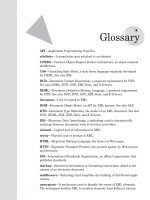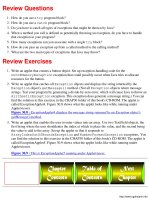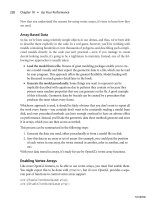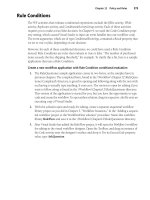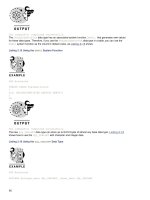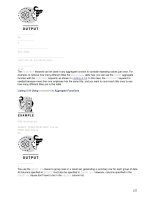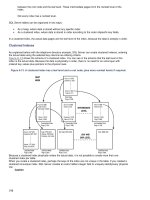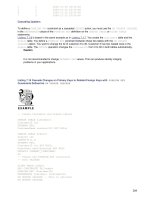programming XML by Example phần 8 pptx
Bạn đang xem bản rút gọn của tài liệu. Xem và tải ngay bản đầy đủ của tài liệu tại đây (369.4 KB, 53 trang )
How XML Helps
As soon as there are two or more parties, they need to communicate.
Currently, two approaches are particularly popular for client/server applica-
tions:
• middleware such as CORBA (Common Object Request Broker
Architecture), DCOM (Distributed Component Object Model), or RPC
(Remote Procedure Call)
• exchange formats such as HTML or XML
Middleware
I won’t cover middleware in great detail (this is an XML book, not a middle-
ware book), but I want to provide you with enough information for a com-
parison.
The basic idea behind middleware is to reduce the effort required to write
distributed applications. Networks are not always safe, reliable, and
dependable. In fact, one could argue that they are exactly the opposite. To
work around these limitations, programmers have to implement specific
protocols.
It is not uncommon for network-specific code to amount to more than 10
times the business code. This process takes time and is not very productive.
Indeed, the time spent wrestling with the network and its security is not
spent solving actual business problems.
Middleware includes tools that deal with the network. For example, a net-
work might fail but middleware has logic to gracefully recover from these
failures. Also, on a network several computers need to collaborate.
Middleware offers tools to manage the interaction between these com-
puters.
Middleware is based on specific protocols but, instead of overwhelming pro-
grammers with details, it hides them. Programmers are free to concentrate
on business issues and, therefore, be more productive.
Listing 11.1 illustrates this. This is a simple CORBA client that appends
one line to an order and confirms it. A server maintains the order.
Listing 11.1: Small CORBA Example
import org.omg.CORBA.*;
public class StockExchangeClient
{
static public void main(String[] args)
356
Chapter 11: N-Tiered Architecture and XML
EXAMPLE
13 2429 CH11 2.29.2000 2:24 PM Page 356
{
String order = args[0],
product = args[1];
int quantity = Integer.parseInt(args[2]);
ORB orb = ORB.init(args,null);
Order remoteOrder = OrderHelper.bind(orb,order);
remoteOrder.appendLine(product,quantity);
remoteOrder.confirm();
}
}
Listing 11.1 is interesting because you can hardly tell it is a distributed
application. The only lines that explicitly deal with networks are these two:
ORB orb = ORB.init(args,null);
Order remoteOrder = OrderHelper.bind(orb,order);
and they are not very difficult. Without going into any details, they connect
to an order on the server. More interestingly, the application can manipu-
late the order, which is a server object, just as if it were a client object:
remoteOrder.appendLine(product,quantity);
remoteOrder.confirm();
That’s the power of middleware; it completely hides the distributed aspect.
Experience shows that middleware works better on LANs or intranets than
on cross-enterprise applications. This is because, with middleware, the
client directly manipulates objects on the server. This leads to a very tight
coupling between the client and the server. It is therefore simpler if both
parties are controlled by the same organization.
NOTE
Middleware gurus are quick to point out that it doesn’t have to be that way. Indeed
there are several mechanisms, including dynamic invocation, that support very flexible
coupling with middleware.
While it is correct technically, in practice, experience shows that most solutions based
on middleware are relatively inflexible and are therefore best suited for internal use.
Common Format
For applications that work across several organizations, it is easier to
exchange documents in a common format. This is how the Web works: A
Web server requests HMTL documents from a Web browser. This process
has proved to scale well to millions of users.
357
How XML Helps
13 2429 CH11 2.29.2000 2:24 PM Page 357
HTML is a good format but it is intended for human consumption only.
XML, as you have seen, is similar but can be manipulated by applications.
XCommerce illustrates how it works (see Figure 11.5).
358
Chapter 11: N-Tiered Architecture and XML
EXAMPLE
Figure 11.5: The Web mall, XCommerce
As you can see, this is an n-tiered application: The client converses with the
mall server. The mall server converses with the XML data server. The data
server itself may be connected to a database server.
XML has many strong points for this setup:
• XML is extensible, which allows the different partners to build on
commonalities while retaining the option to extend the basic services
where appropriate.
• XML is structure-rich, which allows the middle server to process prod-
uct information (such as extracting prices).
• XML is versatile, therefore most data in the application are stored in
XML. In particular, XML is used for configuration information (the list
of merchants), for product information, and to store the orders them-
selves.
• XML scales well. Small merchants can prepare product lists manually
with an editor while larger merchants can generate the list from a
database.
• As a secondary benefit of scalability, XML gives the merchants lots of
flexibility in deploying their solutions. A merchant can start with a
simple solution and upgrade as the business expands.
• XML is based on the Web; therefore, it is often possible to reuse
HTML investments.
13 2429 CH11 2.29.2000 2:24 PM Page 358
• XML is textual, which simplifies testing and debugging (this should
not be neglected because very few applications work flawlessly the
first time).
• XML is cost effective to deploy because many vendors support it; com-
panion standards are also available.
XML for the Data Tiers
XML brings its emphasis on structure, its extensibility, its scalability, and
its versatility to the data tiers. This chapter has discussed the structure
aspect at length already, so let’s review the other features.
Extensibility
Figure 11.6 is the structure for the list of products. Listing 11.2 is an
example of a list of products.
359
XML for the Data Tiers
Figure 11.6: Structure for the list of products
Listing 11.2: Product List in XML
<?xml version=”1.0”?>
<products merchant=”emailaholic”>
<product id=”0”>
<name>Ultra Word Processor</name>
<description>More words per minute than
the competition.</description>
<price>$799.99</price>
</product>
<product id=”1”>
<name>Super Calculator</name>
<description>Cheap and reliable with power saving.</description>
<price>$5.99</price>
</product>
continues
13 2429 CH11 2.29.2000 2:24 PM Page 359
<product id=”2”>
<name>Safest Safe</name>
<description>Choose the authentic Safest Safe.</description>
<price>$1,999.00</price>
</product>
</products>
✔ Obviously, some merchants will want to provide more information than is supported in the
list of products. For example, they will want to add images, manufacturer information, and
more. This is possible using the technique introduced in the section “Building on XML
Extensibility” in Chapter 10 (page 312).
Listing 11.3 illustrates how one merchant can publish additional product
information. The merchant has to provide a style sheet to display the extra
information to the buyer.
Listing 11.3: Extending the Core Format
<?xml version=”1.0”?>
<products merchant=”emailaholic”
xmlns:em=” /><product id=”0”>
<name>Ultra Word Processor</name>
<em:manufacturer>Ultra Word Inc.</em:manufacturer>
<em:image>wordprocessor.jpg</em:image>
<em:warranty>1 month</em:warranty>
<description>More words per minute than
the competition.</description>
<price>$799.99</price>
</product>
<product id=”1”>
<name>Super Calculator</name>
<em:manufacturer>United Calculators Corp.</em:manufacturer>
<em:image>calculator.jpg</em:image>
<em:warranty>6 months</em:warranty>
<description>Cheap and reliable with power saving.</description>
<price>$5.99</price>
</product>
<product id=”2”>
<name>Safest Safe</name>
360
Chapter 11: N-Tiered Architecture and XML
Listing 11.2: continued
13 2429 CH11 2.29.2000 2:24 PM Page 360
<em:manufacturer>Safe Safe Inc.</em:manufacturer>
<em:image>safe.jpg</em:image>
<em:warranty>lifetime</em:warranty>
<description>Choose the authentic Safest Safe.</description>
<price>$1,999.00</price>
</product>
</products>
Scalability
1. Currently, XCommerce has two merchants. Emailaholic, the first mer-
chant, is a large company. It has a Web site with a database of prod-
ucts available online. It dynamically generates XML documents from
its database.
Listing 11.4 is an extract from a servlet that generates the XML document
for Emailaholic. The complete listing is in Chapter 12, “Putting It All
Together: An e-Commerce Example.” Listing 11.5 is a server that
Emailaholic uses to manage its database; again, the complete listing is in
Chapter 12. Listing 11.4 generates XML; Listing 11.5 generates HTML for
a similar document.
Compare both listings and see how similar they are. Both are based on the
same Web technology and both are based on very similar markup lan-
guages. For Emailaholic, it is not much more difficult to write Listing 11.4,
which uses the newer XML, than to write Listing 11.5, which uses the well-
known HTML technology. In practice, it means that Emailaholic can reuse
its HTML experience with XML.
What does it all mean? It means that adding XML in a Web project is easy.
XML is popular because it is that simple.
It is also popular because it is based on many techniques that are already
well known through HTML; therefore, people are rapidly productive with
HTML. I have seen projects where people would take their HTML-based
application and turn it into an XML application in a matter of days, not
weeks.
Listing 11.4: Writing an XML Document
protected void doGet(HttpServletRequest request,
HttpServletResponse response)
throws ServletException, IOException
{
response.setContentType(“application/xml”);
361
XML for the Data Tiers
EXAMPLE
continues
13 2429 CH11 2.29.2000 2:24 PM Page 361
Writer writer = response.getWriter();
String sqlDriver = getInitParameter(“sql.driver”),
sqlURL = getInitParameter(“sql.url”),
sqlUser = getInitParameter(“sql.user”),
sqlPassword = getInitParameter(“sql.password”),
merchant = getInitParameter(“merchant”);
writer.write(“<?xml version=\”1.0\”?>”);
writer.write(“<products merchant=\””);
writer.write(merchant);
writer.write(“\” xmlns:em=\”ilaholic”);
writer.write(“.com/xt/1.0\”>”);
try
{
Class.forName(sqlDriver);
Connection connection =
DriverManager.getConnection(sqlURL,
sqlUser,
sqlPassword);
try
{
Statement stmt = connection.createStatement();
try
{
ResultSet rs =
stmt.executeQuery(“select id, name, “ +
“manufacturer, image, warranty, “ +
“description, price from products”);
while(rs.next())
{
writer.write(“<product id=\””);
writer.write(String.valueOf(rs.getInt(1)));
writer.write(“\”><name>”);
writer.write(rs.getString(2));
writer.write(“</name><em:manufacturer>”);
writer.write(rs.getString(3));
writer.write(“</em:manufacturer><em:image>”);
writer.write(rs.getString(4));
362
Chapter 11: N-Tiered Architecture and XML
Listing 11.4: continued
13 2429 CH11 2.29.2000 2:24 PM Page 362
writer.write(“</em:image><em:warranty>”);
writer.write(rs.getString(5));
writer.write(“</em:warranty><description>”);
writer.write(rs.getString(6));
writer.write(“</description><price>”);
writer.write(formatter.format(rs.getDouble(7)));
writer.write(“</price></product>”);
}
}
finally
{
stmt.close();
}
}
finally
{
connection.close();
}
}
catch(ClassNotFoundException e)
{
throw new ServletException;
}
catch(SQLException e)
{
throw new ServletException(e);
}
writer.write(“</products>”);
writer.flush();
}
Listing 11.5: Writing an HTML Document
protected void doPage(HttpServletRequest request,
HttpServletResponse response,
Connection connection)
throws SQLException, IOException
{
Writer writer = response.getWriter();
363
XML for the Data Tiers
continues
13 2429 CH11 2.29.2000 2:24 PM Page 363
writer.write(“<HTML><HEAD><TITLE>XML Server Console” +
“</TITLE></HEAD><BODY>”);
Statement stmt = connection.createStatement();
try
{
// deleted, see chapter 12 for complete listing
ResultSet rs =
stmt.executeQuery(“select id, name from products”);
writer.write(“<TABLE>”);
while(rs.next())
{
writer.write(“<TR><TD>”);
writer.write(rs.getString(2));
writer.write(“</TD><TD><FORM ACTION=\””);
writer.write(request.getServletPath());
writer.write(“\” METHOD=\”POST\”>”);
writer.write(“ <INPUT TYPE=\”SUBMIT\””);
writer.write(“ VALUE=\”Delete\”>”);
writer.write(“<INPUT TYPE=\”HIDDEN\””);
writer.write(“ NAME=\”action\” VALUE=\”delete\”>”);
writer.write(“</FORM></TD></TR>”);
}
writer.write(“</TABLE>”);
// deleted, see chapter 12 for complete listing
}
finally
{
stmt.close();
}
writer.write(“</BODY></HTML>”);
writer.flush();
}
2. XMLi is the second merchant. XMLi is a smaller company and it
doesn’t have a Web site. Fortunately, there is more than one way to
generate XML documents. A small merchant, like XMLi, can prepare
its list of products (in XML) manually and upload the list to the mall
site. Figure 11.7 shows the editor XMLi uses.
364
Chapter 11: N-Tiered Architecture and XML
Listing 11.4: continued
13 2429 CH11 2.29.2000 2:24 PM Page 364
✔ This editor is nothing more than a style sheet and JavaScript so it is very simple to deploy.
The source code is in the section “Viewer and Editor” in Chapter 12 (page 444).
365
XML for the Data Tiers
Figure 11.7: Editing the list of products
Versatility
The Web mall needs to forward the orders to the merchants. When a visitor
buys from the Web site, the order is also represented as an XML document.
So, XML serves all of the data exchange needs. Listing 11.6 shows a sample
order.
Listing 11.6: An Order in XML
<?xml version=”1.0”?>
<order>
<buyer name=”John Doe”
street=”34 Fountain Square Plaza”
region=”OH”
postal-code=”45202”
locality=”Cincinnati”
country=”US”
email=””/>
<product quantity=”1”
id=”xmli”
name=”XML Book”
price=”$19.99”/>
</order>
EXAMPLE
13 2429 CH11 2.29.2000 2:24 PM Page 365
The order benefits from all the other qualities of XML. In particular, the
middle tier posts the order to the Emailaholic site, where it is automatically
parsed and loaded into a database.
Orders for XMLi are not posted to a Web site because XMLi has no Web
site. Instead, the orders are saved in files. To review its order, XMLi applies
a style sheet to them.
Again, the complete source code for this is in the next chapter. However, the
underlying idea is that XML is scalable: It works for Emailaholic, which
built a specialized server, but it also works for XMLi, which needs a simple,
browser-based tool.
XML on the Middle Tier
On the middle tier, XML is attractive because of the large range of tools
and standards that support it—mainly XML parsers and XSL processors.
Tools reduce the cost of development. In fact, many operations can be
implemented as XSL style sheets.
1. A style sheet can format the list of products for the end user. By
bundling an inexpensive XSL processor on the middle tier, the inter-
face with the buyers is built in no time.
Listing 11.7 shows the style sheet that formats the list of products seen pre-
viously in Listing 11.2. Figure 11.8 is the result in a browser.
✔ The section “The Middle Tier” in Chapter 12 (page 386) presents the servlet that applies
these style sheets.
Listing 11.7: Formatting the List of Products
<?xml version=”1.0” encoding=”ISO-8859-1”?>
<xsl:stylesheet xmlns:xsl=” />xmlns=” /><xsl:output method=”html”/>
<xsl:template match=”/”>
<HTML>
<HEAD>
<TITLE>Online Shop</TITLE>
</HEAD>
<BODY>
<TABLE BORDER=”0”><xsl:for-each select=”products/product”>
<TR><TD><B><A><xsl:attribute name=”HREF”>/shop/<xsl:value-of
366
Chapter 11: N-Tiered Architecture and XML
EXAMPLE
13 2429 CH11 2.29.2000 2:24 PM Page 366
select=”/products/@merchant”/>/<xsl:value-of
select=”@id”/></xsl:attribute><xsl:value-of
select=”name”/></A></B><BR/>
<xsl:value-of select=”price”/></TD>
<TD><FORM ACTION=”/shop/checkout” METHOD=”POST”>
<INPUT TYPE=”HIDDEN” NAME=”merchant”>
<xsl:attribute name=”value”><xsl:value-of
select=”/products/@merchant”/></xsl:attribute>
</INPUT>
<INPUT TYPE=”HIDDEN” NAME=”product”>
<xsl:attribute name=”value”><xsl:value-of
select=”@id”/></xsl:attribute>
</INPUT>
<INPUT TYPE=”HIDDEN” NAME=”quantity” VALUE=”1”/>
<INPUT TYPE=”SUBMIT” VALUE=”Buy”/>
</FORM></TD>
</TR></xsl:for-each></TABLE>
</BODY>
</HTML>
</xsl:template>
</xsl:stylesheet>
367
XML on the Middle Tier
OUTPUT
Figure 11.8: The list of products in a browser
2. Thanks to style sheets, merchants can customize the presentation of
their sites. Emailaholic is not happy with the standard style sheet,
and it provides its own style sheet (see Listing 11.8). This style sheet
works with documents such as the one in Listing 11.3.
13 2429 CH11 2.29.2000 2:24 PM Page 367
Again, this style sheet will work with the servlet in Chapter 12. The impor-
tant thing to remember is that each merchant can add tags to the product
description and provide a style sheet that takes advantage of the new tags.
Listing 11.8: The Emailaholic Style Sheet
<?xml version=”1.0” encoding=”ISO-8859-1”?>
<xsl:stylesheet xmlns:xsl=” />xmlns:em=” />xmlns=” /><xsl:output method=”html”/>
<xsl:template match=”/”>
<HTML>
<HEAD>
<TITLE>Emailaholic.com</TITLE>
</HEAD>
<BODY BGCOLOR=”orange”>
<CENTER><TABLE BGCOLOR=”white” WIDTH=”50%”><TR><TD><CENTER>
<TABLE BORDER=”0”><xsl:for-each
select=”products/product”><TR>
<TD><B><A><xsl:attribute
name=”HREF”>/shop/emailaholic/<xsl:value-of
select=”@id”/></xsl:attribute><xsl:value-of
select=”name”/></A></B><BR/>
by <xsl:value-of select=”em:manufacturer”/><BR/>
<xsl:value-of select=”price”/></TD>
<TD><FORM ACTION=”/shop/checkout” METHOD=”POST”>
<INPUT TYPE=”HIDDEN” NAME=”merchant”
VALUE=”emailaholic”/>
<INPUT TYPE=”HIDDEN” NAME=”product”>
<xsl:attribute name=”value”><xsl:value-of
select=”@id”/></xsl:attribute>
</INPUT>
<INPUT TYPE=”HIDDEN” NAME=”quantity” VALUE=”1”/>
<INPUT TYPE=”SUBMIT” VALUE=”Buy”/>
</FORM></TD>
</TR></xsl:for-each></TABLE>
</CENTER></TD></TR></TABLE></CENTER>
368
Chapter 11: N-Tiered Architecture and XML
13 2429 CH11 2.29.2000 2:24 PM Page 368
</BODY>
</HTML>
</xsl:template>
</xsl:stylesheet>
This style sheet differs from Listing 11.7 because it uses the information in
the namespace. It also adopts a differ-
ent presentation; see Figure 11.9 for the result in a browser.
369
XML on the Middle Tier
OUTPUT
Figure 11.9: Emailaholic style sheet in a browser
3. Finally, style sheets are useful for filtering information. The style
sheets in Listings 11.7 and 11.8 do not present all the information
from Listings 11.2 and 11.3. They both ignore the description. Listing
11.8 ignores most of Emailaholic-specific information. This keeps the
list of products small and quicker to download.
Style sheets in Listings 11.9 and 11.10 provide more details. They use all
the information available in the original document, but they present one
product only. Listing 11.9 is the standard mall style sheet whereas Listing
11.10 is specific to Emailaholic.
These style sheets also work with the servlet introduced in Chapter 12. The
idea, however, is that the style sheet is used to present more or less
detailed information to the user.
EXAMPLE
13 2429 CH11 2.29.2000 2:24 PM Page 369
Listing 11.9: Product.xsl
<?xml version=”1.0” encoding=”ISO-8859-1”?>
<xsl:stylesheet xmlns:xsl=” />xmlns=” /><xsl:output method=”html”/>
<xsl:template match=”/”>
<HTML>
<HEAD>
<TITLE>Online Shop</TITLE>
</HEAD>
<BODY>
<P><B><xsl:value-of select=”product/name”/></B><BR/>
<xsl:value-of select=”product/description”/><BR/>
<xsl:value-of select=”product/price”/>
<FORM ACTION=”/shop/checkout” METHOD=”POST”>
<INPUT TYPE=”TEXT” SIZE=”3” NAME=”quantity” VALUE=”1”/>
<INPUT TYPE=”SUBMIT” VALUE=”Buy”/>
<INPUT TYPE=”HIDDEN” NAME=”merchant”>
<xsl:attribute name=”value”><xsl:value-of
select=”product/@merchant”/></xsl:attribute>
</INPUT>
<INPUT TYPE=”HIDDEN” NAME=”product”>
<xsl:attribute name=”value”><xsl:value-of
select=”product/@id”/></xsl:attribute>
</INPUT>
</FORM></P>
</BODY>
</HTML>
</xsl:template>
</xsl:stylesheet>
Listing 11.10: Emailaholic Style Sheet for Product
<?xml version=”1.0” encoding=”ISO-8859-1”?>
<xsl:stylesheet xmlns:xsl=” />xmlns:em=” />xmlns=” />370
Chapter 11: N-Tiered Architecture and XML
13 2429 CH11 2.29.2000 2:24 PM Page 370
<xsl:output method=”html”/>
<xsl:template match=”/”>
<HTML>
<HEAD>
<TITLE>Emailaholic.com</TITLE>
</HEAD>
<BODY BGCOLOR=”orange”>
<CENTER><TABLE BGCOLOR=”white” WIDTH=”50%”><TR><TD><CENTER>
<IMG ALIGN=”RIGHT”><xsl:attribute
name=”SRC”>:81/<xsl:value-of
select=”product/em:image”/></xsl:attribute></IMG>
<B><xsl:value-of select=”product/name”/></B><BR/>
by <I><xsl:value-of
select=”product/em:manufacturer”/></I><BR/>
<xsl:value-of select=”product/description”/><BR/>
<SMALL>Warranty: <xsl:value-of
select=”product/em:warranty”/></SMALL><BR/>
<xsl:value-of select=”product/price”/>
<FORM ACTION=”/shop/checkout” METHOD=”POST”>
<INPUT TYPE=”TEXT” SIZE=”3” NAME=”quantity” VALUE=”1”/>
<INPUT TYPE=”SUBMIT” VALUE=”Buy”/>
<INPUT TYPE=”HIDDEN” NAME=”merchant”
VALUE=”emailaholic”/>
<INPUT TYPE=”HIDDEN” NAME=”product”>
<xsl:attribute name=”value”><xsl:value-of
select=”product/@id”/></xsl:attribute>
</INPUT>
</FORM>
</CENTER></TD></TR></TABLE></CENTER>
</BODY>
</HTML>
</xsl:template>
</xsl:stylesheet>
Figure 11.10 shows the result in a browser. Notice that more information is
available than shown in Figure 11.9.
371
XML on the Middle Tier
OUTPUT
13 2429 CH11 2.29.2000 2:24 PM Page 371
Figure 11.10: Product information in a browser
Client
The last tier is the client. Ultimately, it will be possible to send XML to
the client and apply style sheets on the client. Currently, I would advise
against sending any XML to the client. It makes more sense to convert to
HTML on the server.
There are several problems with XML on the client:
• Currently, XML is supported only by the latest generation of browsers.
Studies show that surfers are less likely to update their browsers than
they were in the past, so implementation might take a while.
• Even if your target audience has XML-capable browsers, not all
browsers were born equal. There are important differences between
version 4.0 and version 5.0 of Internet Explorer and Mozilla, for
example.
• XSL implementations are particularly unstable. Internet Explorer 4.0
supported a very early version of XSL. Internet Explorer 5.0 is closer
to the standard, but will need changes. Currently, no browser has a
complete implementation of XSL.
In conclusion, it will probably take more than two years before XML will be
common. Currently converting XML to HTML on the server is the safe solu-
tion. It buys you the best of both worlds: It works with older browsers but it
still allows you to take advantage of XML in your applications.
In the previous chapters, you saw many examples that performed lots of
processing on the client side. However, in each case, I warned that it would
work only with specific browsers. XCommerce relies heavily on server-side
conversion because it is a more realistic example.
372
Chapter 11: N-Tiered Architecture and XML
13 2429 CH11 2.29.2000 2:24 PM Page 372
If you need special processing on the client, you can always resort to
JavaScript. It is even possible to combine XSL and JavaScript. Listing
11.11 demonstrates how to generate client-side JavaScript from a server-
side XSL style sheet.
Listing 11.11: Generating JavaScript from XSL
<?xml version=”1.0” encoding=”ISO-8859-1”?>
<xsl:stylesheet xmlns:xsl=” />xmlns=” /><xsl:output method=”html”/>
<xsl:template match=”/”>
<HTML><HEAD><TITLE>Product List Editor</TITLE>
<SCRIPT LANGUAGE=”JavaScript” SRC=”editor.js”>
<xsl:text> </xsl:text></SCRIPT>
<SCRIPT LANGUAGE=”JavaScript”><xsl:comment>
function load(form)
{
<xsl:for-each select=”products/product”>
doAddProduct(form,
“<xsl:value-of select=”@id”/>”,
“<xsl:value-of select=”name”/>”,
“<xsl:value-of select=”price”/>”,
“<xsl:value-of select=”description”/>”);
</xsl:for-each>
}
// </xsl:comment>
</SCRIPT>
</HEAD>
<BODY ONLOAD=”load(document.controls)”>
<CENTER>
<FORM NAME=”controls” METHOD=”POST”
ACTION=”editor”>
ID: <INPUT TYPE=”TEXT” NAME=”id” SIZE=”3”/>
Name: <INPUT TYPE=”TEXT” NAME=”name”/>
Price: <INPUT TYPE=”TEXT” NAME=”price”
SIZE=”7”/><BR/>
Description:<BR/>
373
XML on the Middle Tier
EXAMPLE
continues
13 2429 CH11 2.29.2000 2:24 PM Page 373
<TEXTAREA NAME=”description” ROWS=”5”
COLS=”50”/><BR/>
<SELECT NAME=”productlist” SIZE=”5”
WIDTH=”250”/><BR/>
<INPUT TYPE=”BUTTON” VALUE=”Add”
ONCLICK=”addProduct(controls)”/>
<INPUT TYPE=”BUTTON” VALUE=”Delete”
ONCLICK=”deleteProduct(controls)”/><BR/>
Password: <INPUT TYPE=”PASSWORD” NAME=”pwd”/>
<INPUT TYPE=”SUBMIT” VALUE=”Save”
ONCLICK=”exportProduct(controls)”/>
<INPUT TYPE=”HIDDEN” NAME=”xmldata”/>
<INPUT TYPE=”HIDDEN” NAME=”merchant”>
<xsl:attribute name=”VALUE”>
<xsl:value-of select=”products/@merchant”/>
</xsl:attribute>
</INPUT>
</FORM>
</CENTER>
</BODY>
</HTML>
</xsl:template>
</xsl:stylesheet>
This is useful because the style sheet populates a list and data structure for
the JavaScript application. The following extract (taken from Listing 11.11)
is used to generate the JavaScript code based on the XML document:
function load(form)
{
<xsl:for-each select=”products/product”>
doAddProduct(form,
“<xsl:value-of select=”@id”/>”,
“<xsl:value-of select=”name”/>”,
“<xsl:value-of select=”price”/>”,
“<xsl:value-of select=”description”/>”);
</xsl:for-each>
}
374
Chapter 11: N-Tiered Architecture and XML
Listing 11.11: continued
13 2429 CH11 2.29.2000 2:24 PM Page 374
Applying the style sheet in Listing 11.11 to the XML document in Listing
11.3 generates the following JavaScript code. Note that this JavaScript code
reflects the products in the XML document. If you used a different XML
document for the list of products, the JavaScript would reflect that
doAddProduct(“0”,
“Ultra Word Processor”,
“More words per minute than the competition.”,
“$799.99”);
doAddProduct(“1”,
“Super Calculator”,
“Cheap and reliable with power saving.”,
“$5.99”);
doAddProduct(“2”,
“Safest Safe”,
“Choose the authentic Safest Safe.”,
“$1,999.00”);
CAUTION
Note that the JavaScript code is generated on the server but it is executed on the
client.
NOTE
I advise against sending XML to the client because there are not enough XML-capable
browsers.
This might not be true on an intranet. An intranet is a controlled environment; there-
fore, you might be able to control which browser is being used. Moreover, you can tailor
your documents to the appropriate browsers.
If, however, the intranet is large, stick to server-side conversion of XML. In a large
intranet, it is difficult to upgrade all the users simultaneously. If your appplication
depends on Internet Explorer 5.0 and 500 users out there are still using Internet
Explorer 4.0, it might not be possible to upgrade them.
Server-Side Programming Language
XCommerce relies extensively on XSL. From a certain point of view, XSL is
used as a scripting language for XML documents.
However, there are features that are not possible with XSL. For example,
there is no standard mechanism to split a document. This would be useful
for separating the list of products in a number of product documents.
375
Server-Side Programming Language
13 2429 CH11 2.29.2000 2:24 PM Page 375
Therefore, XSL is not enough. A medium-sized XML application needs code
to compare documents, compile new documents, handle user authentica-
tion, and more. All these features are not being covered, or not properly
covered, by XSL.
The main options for server-side programming languages that work well
with XML are Perl, JavaScript, Python, Omnimark, and Java.
Perl
Perl is a scripting language. It is popular for CGI scripting because it offers
superior text manipulation. However, with XML, you’d rather manipulate
the text with XSL, so many of the features in Perl are not as important
with XML as with raw text.
JavaScript
JavaScript is also a scripting language. It is particularly popular for
browsers. Many examples in this book rely on JavaScript. There are server-
side versions of JavaScript from Microsoft and Netscape. Microsoft offers
Active Server Page (ASP). Netscape supports Server-Side JavaScript
(SSJS).
Although ASP and SSJS are very similar, they are incompatible. ASP and
SSJS encourage you to mix JavaScript statements in an HTML or an XML
page. The server, not the browser, executes the script to generate the final
page. Listing 11.12 shows you how to use SSJS to create an XML document
with product information.
Listing 11.12: Creating XML with SSJS
<SERVER>
deleteResponseHeader(“content-type”)
addResponseHeader(“content-type”,”application/xml”)
database.connect(“ODBC”,”products”,”SYSDBA”,”masterkey”,””)
product = database.cursor(“select * from products where id = ‘“ + request.id + “‘“)
product.next()
</SERVER><product>
<name><SERVER>write(product.name)</SERVER></name>
<description><SERVER>write(product.description)</SERVER></description>
<price><SERVER>write(product.price);product.close()</SERVER></price>
</product>
The first few lines change the type of the document to XML. Next, it con-
nects to the database. Finally, it reads various information from the data-
base and inserts it into an XML document.
376
Chapter 11: N-Tiered Architecture and XML
EXAMPLE
13 2429 CH11 2.29.2000 2:24 PM Page 376
The major problem with JavaScript is that it is not portable. An application
developed with Microsoft’s ASP does not work on Netscape servers and vice
versa. Obviously, ASP is available only on Windows Web servers. Using
JavaScript with Apache on Linux is simply not an option.
Python
Python is an object-oriented scripting language with a very pleasant syn-
tax. Python offers an XML parser. Although Python is rapidly gaining in
popularity, it is yet not as popular as Perl and JavaScript.
There is a Java implementation of Python which gives you access to all the
Java tools.
Omnimark
Omnimark is another scripting language that was developed specifically to
process SGML documents. It was later extended to support XML. If you
need a scripting language to manipulate XML documents, Omnimark is a
very good choice.
The major advantages of Omnimark are that it is available free of charge
from www.omnimark.com, it runs on many platforms, it has built-in support
for text manipulation and XML, and it has a compiler.
However, Omnimark is not well known outside of SGML circles and it is a
proprietary language.
Java
The last option is Java. This is the language I have used for most of
XCommerce (there is some client-side JavaScript as well). Keep in mind
that these are not client-side applets, but Java applications running on the
server.
Java has many strong points for XML development:
• Many XML tools are available in Java. Indeed, most of the XML tools
(parser, XSL processor, XQL engine, and so on) were first made avail-
able for Java.
• Java is highly portable. There are versions of Java for all the major
Web servers and then some.
• Java is a typed language and it is compiled. The compiler catches
many errors. This is important for server-side programming because a
faulty script can crash your server.
• There are several high-quality development environments available,
so you can choose the one that works best for you.
377
Server-Side Programming Language
13 2429 CH11 2.29.2000 2:24 PM Page 377
• Many vendors support Java. You have an ample supply of books, com-
ponents, and services.
If you are familiar with JavaScript but you think Java is too complex, think
twice. With XML, you will write more XSL code than Java or JavaScript
code, anyway. You really need not worry about complex concepts in Java.
✔ If you are not familiar with Java but you would like to learn enough Java to run the
examples, turn to Appendix A, “Crash Course on Java,” (page 457).
What’s Next
The next chapter contains the entire source code for XCommerce. It pro-
vides a good illustration of what is possible with XML.
378
Chapter 11: N-Tiered Architecture and XML
13 2429 CH11 2.29.2000 2:24 PM Page 378
13 2429 CH11 2.29.2000 2:24 PM Page 379
14 2429 CH12 2.29.2000 2:25 PM Page 380

